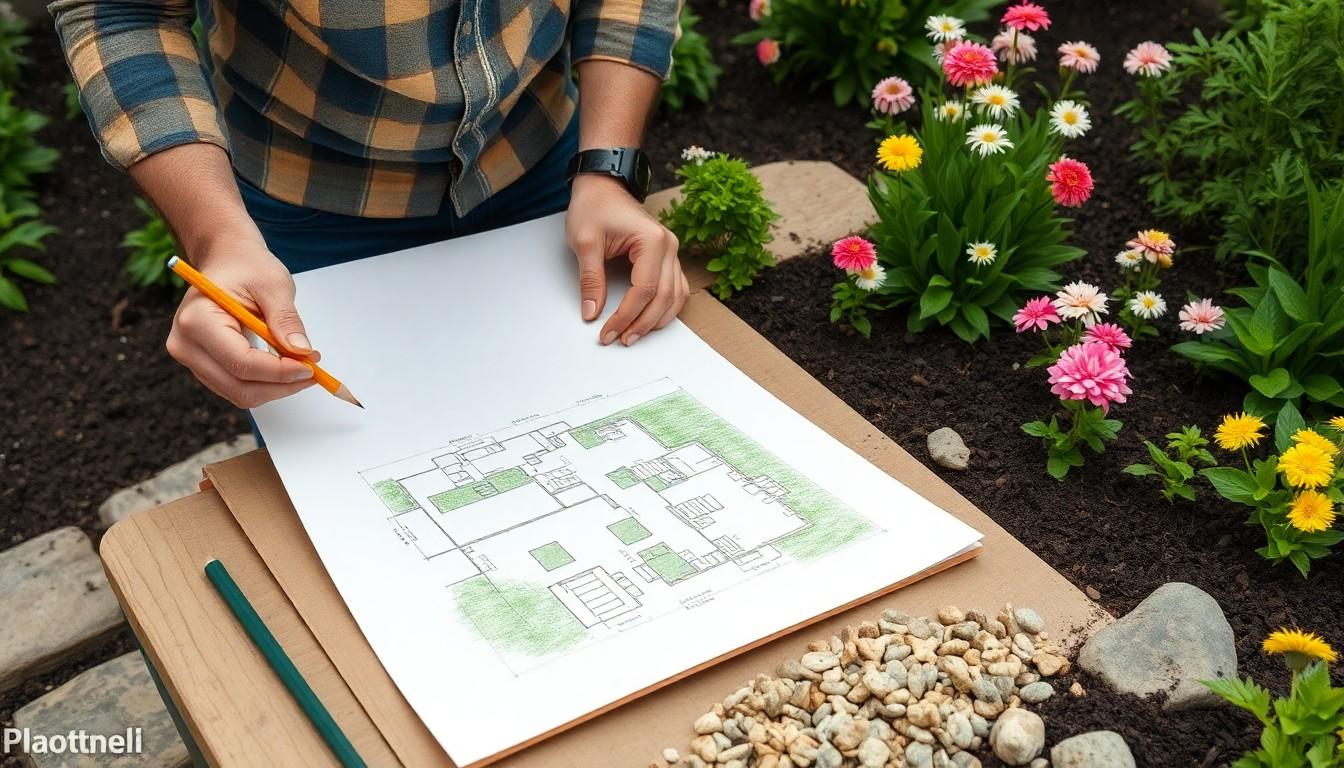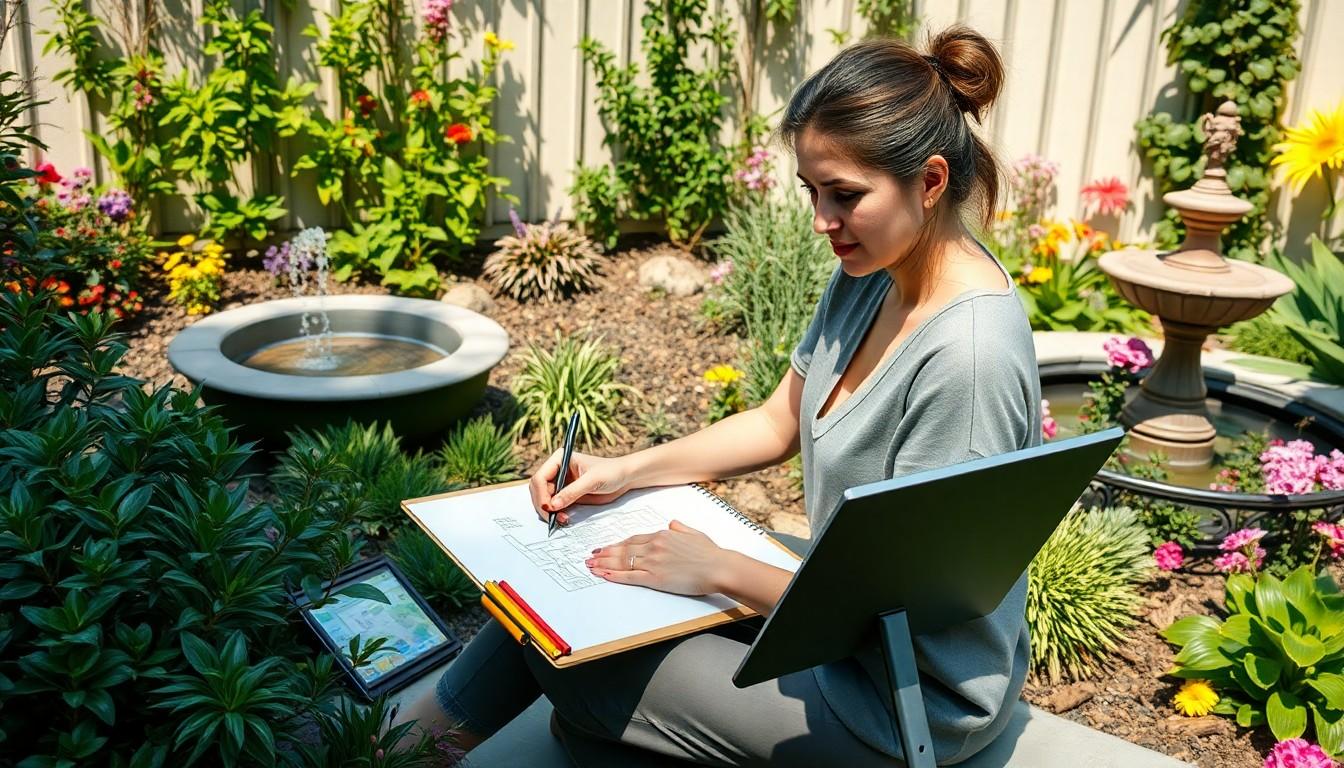Imagine stepping into a world where your backyard transforms into a breathtaking oasis, complete with lush greenery and vibrant blooms. Landscape design drawing is the magic wand that turns those dreams into reality. It’s not just about plants and paths; it’s about crafting a space that reflects personality and style.
Landscape Design Drawing
Landscape design drawing serves as a crucial tool for crafting well-designed outdoor areas. Such drawings encapsulate the vision for a unique environment, integrating various functional and aesthetic components.
Definition and Importance
Landscape design drawing represents a visual interpretation of an outdoor area. It includes plans and sketches that communicate ideas for layout, plant selection, and material choices. These drawings facilitate communication between designers, clients, and contractors, ensuring that everyone aligns with the project vision. Clarity in design reduces misunderstandings and leads to a more successful execution. The importance of landscape design drawings lies in their ability to translate abstract ideas into tangible designs, guiding the development of harmonious and functional spaces.
Key Elements of Landscape Design
Key elements of landscape design encompass various aspects that contribute to a cohesive plan. First, plants add color, texture, and seasonal interest to the landscape. Second, hardscape materials such as patios and walkways provide structure and accessibility. Third, water features can enhance tranquility and liveliness within a design. Fourth, lighting plays a vital role in highlighting features and ensuring safety. Lastly, topography affects drainage, sun exposure, and plant selection. Collectively, these elements work together, creating a balanced and visually appealing outdoor environment.
Techniques and Tools

Landscape design drawing incorporates various techniques and tools to bring ideas to life. These methods enhance the design process, whether through traditional or digital means.
Traditional Hand Drawing
Hand drawing remains a foundational technique in landscape design. Designers use pencils, markers, and paper to create initial sketches that capture the essence of a space. This method emphasizes creativity and personal expression. It allows for flexibility during the planning phase, enabling quick adjustments based on client feedback. Moreover, hand-drawn sketches impart a unique, artistic touch that digital tools sometimes lack. Designers appreciate the tactile nature of this approach, making it valuable for brainstorming and concept development.
Digital Landscape Design Tools
Digital tools revolutionize landscape design, offering precision and efficiency. Software like AutoCAD, SketchUp, and Adobe Illustrator provides advanced features for creating detailed plans and 3D models. These programs enable designers to visualize projects realistically, facilitating smart adjustments in real-time. Users can easily overlay images, adjust dimensions, and experiment with color palettes or textures. Collaboration also improves, as digital files allow easy sharing among clients and contractors. Overall, digital tools enhance creativity while streamlining the design process, making them essential in modern landscape architecture.
Common Styles in Landscape Design Drawing
Various styles in landscape design drawing cater to diverse tastes and functions. Each style encapsulates specific elements that contribute to the overall character of an outdoor space.
Formal Garden Design
Formal garden design features symmetry and geometric shapes. This style often includes manicured hedges, clipped shrubs, and well-defined pathways. Patterns frequently emerge in plantings, emphasizing organization and structure. Designers use layouts that create a sense of balance, making it appealing to those who enjoy order. Water features like fountains often punctuate formal designs, serving as focal points that draw the eye. Classic materials such as stone and brick support the elegant aesthetic, reinforcing the grandeur of formal gardens. This style aligns with traditional architecture, enhancing the cohesion of the overall landscape.
Informal Garden Design
Informal garden design embraces a more relaxed approach. Naturalistic planting patterns create an inviting atmosphere, fostering connection with nature. Designers often select diverse plant species that offer varying colors and textures, making each area unique. Pathways meander through spaces, inviting exploration and discovery. This style encourages a free-flowing arrangement, promoting spontaneity in plant selection. Organic shapes often dominate, creating gentle transitions between different garden sections. Accessories like rustic furniture and natural stones add to the charm, making informal gardens feel warm and welcoming.
Factors to Consider
Considerations in landscape design drawing play a crucial role in achieving a harmonious outdoor space. Key factors include site analysis and environmental considerations.
Site Analysis
Conducting a thorough site analysis ensures the design aligns with the existing conditions. Examine the topography, soil type, and drainage patterns to inform design choices. Identify existing plants and hardscape elements that can enhance the planned layout. Assess sunlight exposure and wind patterns to optimize plant selection and placement. Consider accessibility and view points to maximize the site’s potential for enjoyment. Gathering data on local wildlife can also inform selections that attract or repel specific species.
Environmental Considerations
Addressing environmental considerations is vital for sustainability in landscape design. Analyze local climate conditions, including temperature and rainfall, to select appropriate plant species. Understand the ecosystem services provided by plants, such as carbon sequestration and habitat creation. Incorporating native plants promotes biodiversity and reduces water usage. Evaluate materials for their environmental impact, prioritizing those with sustainable sourcing. Implementing permeable surfaces in hardscape design enhances water management and minimizes runoff. These actions create a balanced relationship between the landscape and its ecosystem.
Create a Captivating Outdoor Space
Landscape design drawing is essential for anyone looking to create a captivating outdoor space that reflects personal style. By combining artistic vision with practical considerations, these drawings bridge the gap between concept and reality. They not only facilitate communication among all parties involved but also help in visualizing the final outcome.
Whether opting for traditional hand sketches or modern digital tools, the process remains a blend of creativity and technical skill. Understanding various design styles and environmental factors ensures that the final design is both beautiful and sustainable. Ultimately, landscape design drawing empowers individuals to transform their outdoor areas into harmonious environments that enhance their quality of life.

